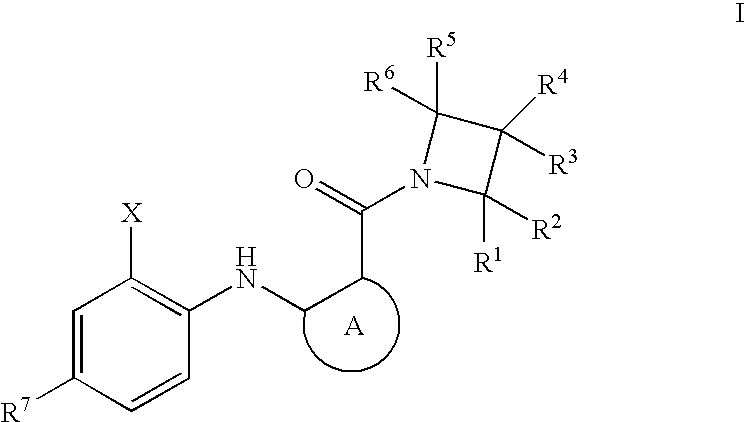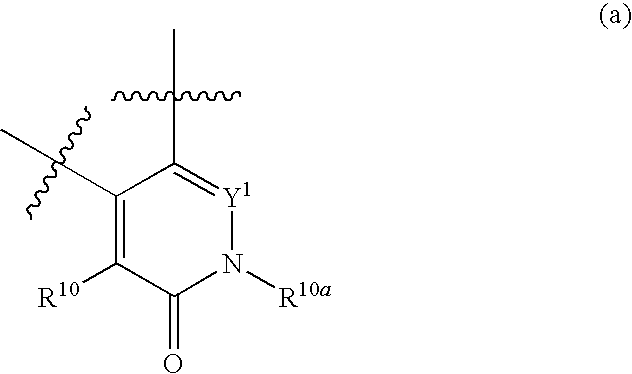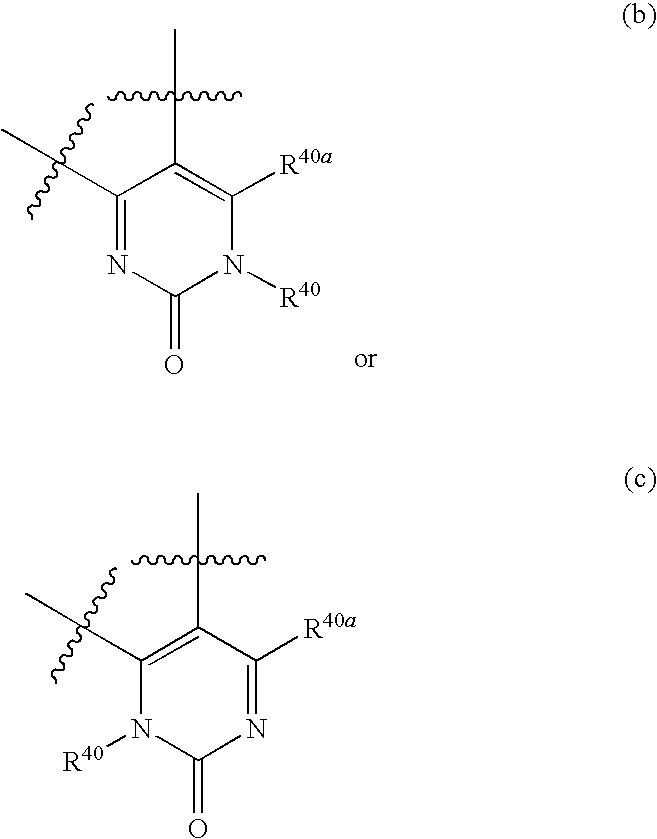Azetidines as MEK inhibitors for the treatment of proliferative diseases
a technology of proliferative diseases and azetidines, which is applied in the direction of biocide, dermatological disorders, drug compositions, etc., can solve the problems of reducing affecting the transforming ability of mutant ras, and affecting the expression of dominant negative mek
- Summary
- Abstract
- Description
- Claims
- Application Information
AI Technical Summary
Benefits of technology
Problems solved by technology
Method used
Image
Examples
example 1
1-({3,4-difluoro-2-[(2-fluoro-4-iodophenyl)amino]phenyl}carbonyl)azetidin-3-ol
[0503]
[0504]3,4-Difluoro-2-[(2-fluoro-4-iodophenyl)amino]benzoic acid (2.1 g, 5.3 mmol), prepared using procedures similar to those in U.S. Pat. No. 7,019,033, was taken into DMF (10 mL) followed by addition of PyBOP (2.6 g, 5.3 mmol) and the mixture was allowed to stir at room temperature over 15 minutes. Azetidin-3-ol hydrochloride (870 mg, 8.0 mmol) and DIPEA (1.85 mL, 11.2 mmol) was then added and the mixture was allowed to stir an additional hour at room temperature. The mixture was then partitioned with ethyl acetate and 0.5 M aqueous sodium hydroxide solution. The organic layer was then washed with water (3×) then brine and dried over anhydrous sodium sulfate. Filtration and concentration followed by silica gel flash chromatography using ethyl acetate:hexanes (5:1) eluent afforded 1-({3,4-difluoro-2-[(2-fluoro-4-iodophenyl)amino]phenyl}carbonyl)azetidin-3-ol (2.09 g, 87% yield) as a colorless amorph...
example 1 (
Example 1(e)
[0510]1-({3,4-Difluoro-2-[(2-fluoro-4-iodophenyl)amino]phenyl}carbonyl)azetidine-3-carboxylic acid: 1H NMR (400 MHz, CDCl3): 7.79 (b, 2H), 7.42-7.38 (dd, 1H), 7.34-7.32 (dt, 1H), 7.15-7.11 (m, 1H), 6.89-6.83 (m, 1H), 6.65-6.60 (m, 1H), 4.46-4.29 (m, 4H), 3.55-3.47 (m, 1H); MS (EI) for C17H12F3IN2O3: 477 (MH+).
example 2
N-[1-({3,4-Difluoro-2-[(2-fluoro-4-iodophenyl)amino]phenyl}carbonyl)azetidin-3-yl]-N2,N2-diethylglycinamide
[0511]
[0512]A solution of 3,4-difluoro-2-[(2-fluoro-4-iodophenyl)amino]benzoic acid (200 mg, 0.51 mmol), prepared using procedures similar to those in U.S. Pat. No. 7,019,033, PyBOP (256 mg, 0.51 mmol), commercially available tert-butyl azetidin-3-ylcarbamate (131 mg, 0.77 mmol) and N,N-diisopropylethylamine (180 μL, 1.02 mmol) in dimethylformamide (3 mL) was stirred at room temperature for 15 hours. The reaction mixture was partitioned between 5% aqueous lithium chloride and ethyl acetate. The organic portion was washed with 20% aqueous citric acid, saturated aqueous sodium bicarbonate, brine, dried over sodium sulfate, filtered and concentrated in vacuo to afford a brown residue which was purified by silica gel column chromatography eluting with 30% ethyl acetate in hexanes to afford 1,1-dimethylethyl [1-({3,4-difluoro-2-[(2-fluoro-4-iodophenyl)amino]phenyl}carbonyl)azetidin-...
PUM
| Property | Measurement | Unit |
|---|---|---|
| size | aaaaa | aaaaa |
| particle size | aaaaa | aaaaa |
| body weight | aaaaa | aaaaa |
Abstract
Description
Claims
Application Information
 Login to View More
Login to View More - R&D
- Intellectual Property
- Life Sciences
- Materials
- Tech Scout
- Unparalleled Data Quality
- Higher Quality Content
- 60% Fewer Hallucinations
Browse by: Latest US Patents, China's latest patents, Technical Efficacy Thesaurus, Application Domain, Technology Topic, Popular Technical Reports.
© 2025 PatSnap. All rights reserved.Legal|Privacy policy|Modern Slavery Act Transparency Statement|Sitemap|About US| Contact US: help@patsnap.com



